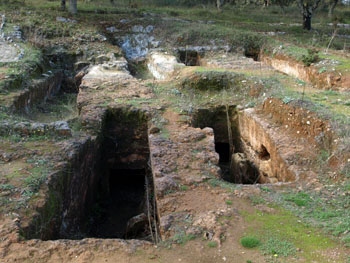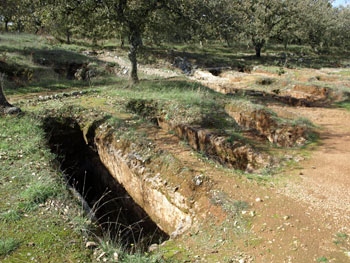Location
The Late Minoan III cemetery of Armeni is located 8 kilometres south of Rethymno on the road to Spili and Ayia Galini. The site has been excavated since 1969 by Yiannis Tzedakis. Over 200 chamber tombs and one tholos tomb have so far been discovered, all oriented towards the northeast and the Vryssinas mountain, which was at one time the site of a peak sanctuary. The chamber tombs are cut into what is quite a soft rock, known locally as kouskouras, but the rock was hard enough for the tombs to remain well preserved.
A network of paths ran through the cemetery. Low banks were created on either side of the paths using the material dug from the tombs and the dromoi. The paths were wide enough for carts carrying larnakes to pass. Smaller and larger tombs, which have been identified as the resting places of respectively the higher status and lower status deceased, were, at least initially, kept separate from each other.
The tombs
The chamber tombs are built in two distinct styles, dug out of the rock. In the first type, there is a large tomb with a long dromos. Steps lead down from ground level to the beginning of the dromos. The second type is a small tomb with a short dromos in the form of a ramp, with no steps or in some cases, no ramp but just a few steps leading directly to the entrance of the tomb. In many tombs, cavities have been carved out of the walls of the dromos either near the entrance to the dromos or near the chamber itself. Objects such as beads, a vase or a small statue would be placed in the cavity. In three of them, infant burials were found. The entrance to each tomb was sealed by a large slab of stone.
The tombs were constructed by partially carving out the dromos for its whole length. Next the chamber was carved out. Sometimes the rock proved too difficult to cut and the tomb was left unfinished. If the carving out of the tomb was a success the dromos was then completed. In cases where it was not possible to complete the tomb offerings of beads were left in the hole that had been dug while a broken vase was often placed in the dromos.
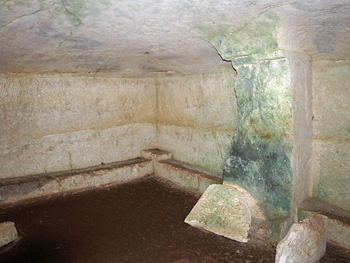
Tomb 159 showing the low bench, the pillar supporting the east wall and the pillar base in the corner of the tomb
There were three types of chamber, circular, semi-circular and in the case of the most prestigious tombs, rectangular with a low bench along one or more of the walls. The most imposing tomb (number 159) had a dromos of 15.50 metres and a staircase with 25 steps. The entrance to the chamber was two metres high, the size of a normal doorway. A pillar supported the east wall. To the left and right of the tomb entrance two rectangular column bases were found, cut in the rock. Tzedakis believes these were used to support wooden columns. Four more bases were found in the four corners of the benches which ran along the four walls of the tomb. A small crypt was covered with a stele. Remains of a wooden stretcher which had been used to carry the body to the tomb were also found. The body would have been placed in one of the larnakes found inside the tomb.
The single tholos tomb dates from LM II to LM IIIA1. The dromos was a little over four and a half metres long and began with two steps and a small cavity cut into the north wall. The entrance to the tomb had been sealed by a large stone slab. The diameter of the circular tomb was 2.45 metres and it had been cut into the rock. The tomb had collapsed but some objects were recovered. These included two bronze swords, three vases and some small beads. Perhaps the most interesting find, however, was a steatite pendant with a Linear A inscription. Although the tomb is the oldest in the cemetery Tzedakis argues that the pendant dates from an even earlier period and must have been passed down to the person whose grave goods it formed part of.
The finds
Among the finds in the tombs were pottery, bronze vessels, tools, jewellery, stone vases and four cylindrical seals from the Middle East.
The pottery finds were particularly numerous and included stirrup jars, cups, small jars, beaked jugs and craters. The ceramics came from various sources including the well-known pottery workshop of LM III Kydonia, the workshops at Knossos and eastern Crete and local workshops. A stirrup jar bearing a Linear B inscription was recovered from one tomb. The inscription was the name of a man well known from the Minoan archives of Linear B inscriptions. Some of the few examples in Crete of vases with enamelled tin were also found in the cemetery and according to Tzedakis attest to trade between Armeni and the eastern Mediterranean.
Clay larnakes decorated with double axes, sacred horns of consecration and scenes of ritual hunting and of bulls were also found. They had been used during the 14th and 13th centuries and provide us with the finest group of larnakes found in Crete. They formed two distinct groups. The first group had four feet and only one panel of the four-sided larnax had been decorated, usually in colours ranging from a reddish-brown to black. The second group of larnakes had six feet and the long side of the larnax was divided into two panels which were decorated using a variety of colours including blue, red and black.
Perhaps the most unusual find was a helmet made of 59 boars' tusks. Each tusk had two holes pierced in it so that it could be attached to the helmet for which the tusks provided the external defensive covering. Most other examples of boars' tusk helmets come from Central Greece. Ceramics found together with the helmet were dated to LM IIIA2 and LM IIIB1. In another tomb a wicker basket with a conical cover was found. Tzedakis aruges that as it was empty it probably originally contained perishable goods, most likely food. Evidence of kilns, presumably used for making the larnakes, was found near the cemetery.
One of the most important finds, however, was the 500 skeletons which gave a wealth of information about the physical appearance of these people, together with their state of health. It would seem that they ate a high-carbohydrate diet but consumed little meat. The average height of the men was 1.67 metres and of women 1.54 metres. Life expectancy was short. For men it was 31 years and for women 28 years. Many of the women lived only to about twenty to twenty five years of age. It is possible that death in childbirth may have been responsible for many of these early female deaths. Among the other causes of death, diseases including bone cancer, tuberculosis, and brucellosis (a bacterial infection passed on to humans from infected animals) were identified as well as accidents. A quarter of the population had lost teeth before their death.
Where did they live?
Archaeologists have long been puzzled as to the whereabouts of the settlement that needed such a large cemetery. Surface surveys did not produce evidence for a settlement and for some time attention focused on the nearby villages of Somatas and Kastellos. Excavations have recently been carried out in and around the village of Kastellos. At a presentation by archaeologists on the current state of research and findings in relation to Armeni, held in Rethymno in the Spring of 2012, Yiannis Tzedakis told the audience that as a result of the recent excavations at Armia, south of Kastellos and Melissokipos, north of the village, they were now reasonably confident that the settlement is to be found beneath the village of Kastellos itself.
Access
The site is a 15-minute drive from Rethymno on the road to Spili and Ayia Galini. It is very clearly signposted. The cemetery is open daily, except Monday, from 8.30 to 3.00 throughout the year and entrance is free. If possible, take a torch since very few of the tombs are lit although the two largest ones now has automatic lighting which comes on when you enter the tomb.
SOURCES: One of the main sources for this article was L. Godart and Y. Tzedakis: ‘Temoignages archéologiques et épigraphiques en Crète occidentale du Néolithique au Minoen Récent III B’ Incunabula Graeca 93 (1992).
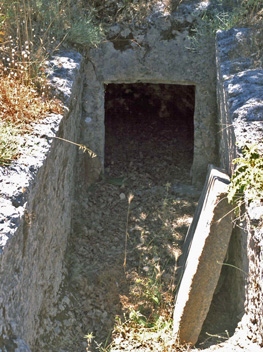
|
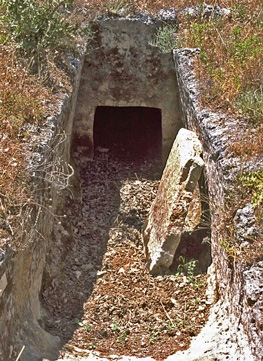
|
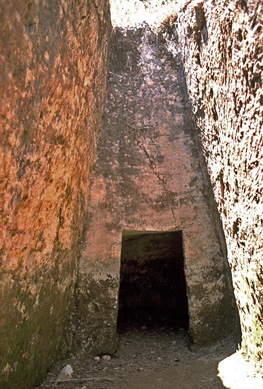 |
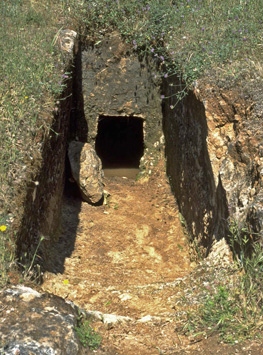
|
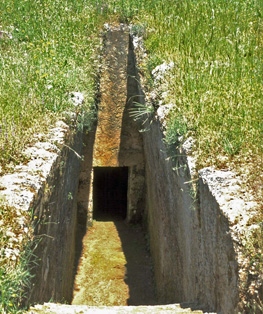
|
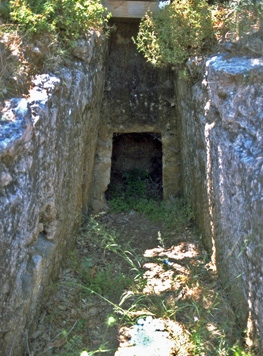
|

